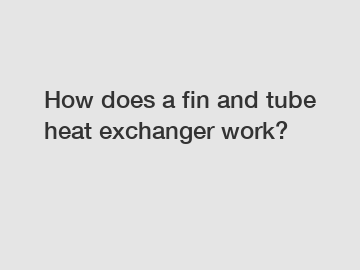Jan. 02, 2024
Minerals & Metallurgy
Link to HPE
Heat exchangers are integral components found in various industries, from power plants to refrigeration systems. Among the many types available, the fin and tube heat exchanger stands out for its efficiency and versatility. In this blog, we delve deep into this fascinating technology, uncovering the secrets behind its functionality and highlighting its immense benefits.
1. The Basics: What is a Fin and Tube Heat Exchanger?

A fin and tube heat exchanger is a highly efficient device designed to transfer heat from one medium to another. It consists of a network of tubes enclosed within a casing, with multiple fins attached along the tube's outer surface. The heat transfer takes place through the walls of the tubes, facilitated by the fins, which enhance the surface area for heat exchange.
2. The Working Principle:
When hot fluid flows through the tubes, heat is conducted from the fluid to the tube walls. As a result, the temperature of the fluid decreases, while the tube walls become warmer. Simultaneously, cool fluid, or possibly air, flows across the fins, absorbing the heat through conduction and/or convection. This cool fluid gains heat energy, which can be utilized elsewhere or dissipated into the environment.
3. Enhancing Heat Transfer Efficiency:
The presence of fins on the outer surface of the tubes significantly enhances heat transfer efficiency. The fins increase the overall surface area exposed to the cool fluid, allowing for more effective heat exchange. Additionally, the fins disrupt the fluid flow, promoting turbulent flow patterns that maximize heat transfer by reducing the formation of a stagnant boundary layer.
4. The Importance of Material Selection:
Both the tubes and fins in heat exchangers must be carefully chosen to ensure optimum performance. The materials should possess excellent thermal conductivity to efficiently transfer heat across their surfaces. Common choices include copper, aluminum, and stainless steel, each offering specific advantages based on the application and environmental considerations.
5. Application Versatility:
Fin and tube heat exchangers find wide-ranging applications across industries. Whether it's cooling engines in automobiles, heat recovery systems in HVAC units, or as condensers and evaporators in refrigeration systems, their versatility makes them an indispensable tool for efficient heat exchange.
6. Design Considerations:
While the basic working principle of fin and tube heat exchangers remains consistent, the design can be tailored to suit specific requirements. Factors such as tube layout, fin density, and overall size influence the performance characteristics of the heat exchanger. Engineers analyze different parameters to optimize the design, ensuring maximum heat transfer with minimal pressure drop.
7. Maintenance and Cleaning:
Maintaining the efficiency of a fin and tube heat exchanger is crucial for its long-term operation. Regular cleaning is often required, as fins can accumulate dust and debris over time, hindering heat transfer. Cleaning methods vary depending on the application, ranging from mechanical brushing to chemical treatments. Proper maintenance ensures consistent performance and prolongs the lifespan of the heat exchanger.
Conclusion:
A fin and tube heat exchanger is a marvel of engineering, utilizing advanced principles of heat transfer to enable efficient energy exchange between fluids. With its versatility, high performance, and adaptability to various applications, this technology has revolutionized numerous industries. Understanding its inner workings empowers us to make informed decisions when it comes to heat exchange processes, leading to increased energy efficiency and overall system performance.
For more information, please visit super duplex stainless steel pipe price.
Previous: Which innovative uses of stainless steel perforated sheets can revolutionize modern architecture?
Next: Which tungsten carbide buttons provide the best durability?
If you are interested in sending in a Guest Blogger Submission,welcome to write for us!
All Comments ( 0 )